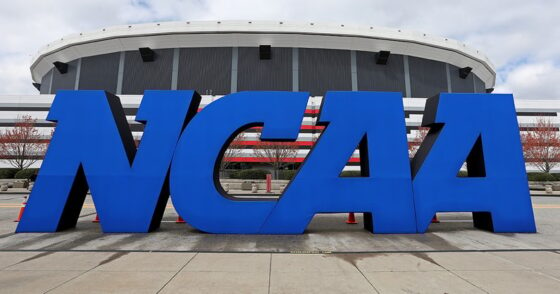The NCAA‘s long-awaited reckoning with its own business model has hit a dramatic pause. The long-expected approval of the groundbreaking House v. NCAA antitrust settlement—which would allow schools to directly pay college athletes—has been temporarily delayed by a federal judge. The stakes couldn’t be higher: billions of dollars in backpay, a radical reshaping of college sports, and now, the very livelihoods of thousands of athletes hang in the balance. While the sports world braces for a July 1 revolution, the NCAA has been given what amounts to a final warning—tweak the deal or risk blowing up the entire framework in open court.
Yahoo! Sports’ analyst Adam Breneman didn’t hold back in his take. “The judge gave NCAA their final warning. Over 5,000 college athletes could lose roster spots because of the NCAA settlement,” he said. Breneman highlighted a core sticking point that has triggered alarm bells from locker rooms to legal offices: current athletes being collateral damage.
Federal Judge Claudia Wilken urged the NCAA to “grandfather in” current players to avoid a mass purge of scholarships mid-career. “It’s not that many, it’s not that expensive,” Wilken said in court. “It would save a lot of goodwill and unhappiness from a lot of students and their parents. So why not just do it and let the athletes stay?”
Breneman further broke down the nightmare scenario the NCAA is trying desperately to avoid—a trial. “So a trial means discovery, which means disclosing internal emails and financial records. A trial risk means damages being tripled the settlement amount of $2.8 billion. A trial could rule against NCAA and establish legal precedent that the NCAA’s current model is illegal,” he explained. In short, this isn’t just about settling accounts. It’s about safeguarding the entire foundation of amateurism. With the threat of legal exposure looming like a sledgehammer, the NCAA has 14 days to fix the language or risk the courtroom door flying wide open.
At the core of this debate lies the question of how this proposed settlement—establishing a $20.5 million annual revenue-sharing cap per school and allocating $2.8 billion in backpay to athletes spanning 2016 to 2024—will reshape the way college sports teams build their rosters. The financial upside is undeniable, especially for high-revenue sports like football and basketball. But the price?
An estimated 5,000 student-athletes potentially getting shown the door, sacrificed for financial balance sheets and new roster limits. These limits would slash football rosters to 105 players—down from the 125+ most Power Five programs typically carry. That means 20 or more athletes per team could be cut, not for performance, but for compliance.
Judge Wilken’s suggestion to “grandfather in” current athletes until their eligibility expires is both humane and pragmatic. It allows the NCAA and its member schools to honor existing scholarship commitments while transitioning to the new model. Yet, NCAA attorney Rakesh Kilaru initially resisted the idea, citing structural complications, though he ultimately agreed to work with plaintiff attorneys toward a solution. The unwillingness to immediately protect these athletes has only deepened skepticism about the NCAA’s true priorities—are they focused on student-athletes or bottom lines?
The final approval hearing was a marathon session that included emotional testimonies from athletes and detailed legal back-and-forths between Wilken and the attorneys. And looming in the background is the wildcard: Congress. Plaintiff attorney Steve Berman warned that if the settlement stalls too long, federal lawmakers could intervene and potentially grant the NCAA antitrust immunity. That would wipe out not just the House case but any legal recourse for athletes in future suits, erasing an estimated $10 billion in exposure for the NCAA.
The NCAA has never been closer to a full-blown identity crisis. For decades, its economic model was protected by the illusion of amateurism, shielded by complex rules and a lack of transparency.
What’s next in the NCAA settlement?
If approved, the landmark antitrust settlement would officially put a bow on three major lawsuits. Carter v. NCAA, House v. NCAA, and Hubbard v. NCAA. But before anyone starts popping champagne, know this: the real chaos might just be starting.
So, what’s next? First up: the revenue-sharing formula. Schools are already sketching out how they’ll slice the pie going forward, and most are leaning toward a model that mirrors the proposed back-payment formula. We’re talking about roughly 75% of future revenue going to football players, 15% to men’s basketball, 5% to women’s basketball, and 5% divvied up among all remaining sports. Of course, each school will have its own spin on it—but this is the general framework power programs are buzzing about behind the scenes.
But here’s the twist—more lawsuits are almost a guarantee….
With the NCAA likely stepping out of the courtroom spotlight, individual schools could become the new legal targets. Title IX concerns are looming, and athletes are paying attention. A women’s basketball player might sue if she feels she’s not getting a fair share. Same goes for a football player watching a rival rake in more money at a different school. So, yes—this settlement could be groundbreaking.
The post CFB Analyst Sounds Alarm as NCAA Faces Final Warning With Over 5000 Athletes at Risk appeared first on EssentiallySports.
